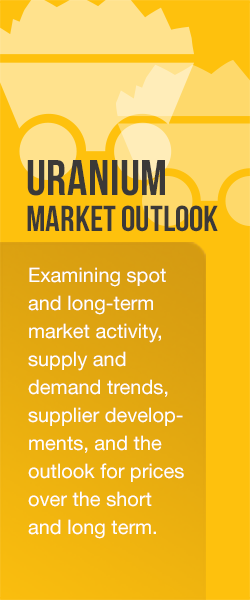Is a Supply Pinch Developing?
Over the last three months, we have witnessed the spot uranium price decline from a peak of $34.00 in late May to its current level of $30.75, due in large part to a slowdown in spot purchasing activity and more encouraging production-related news over the last month, as Cameco expects to restart its Cigar Lake mine in September and wellfield development resumed at Kazakh ISR projects earlier this month. After the spot uranium price increased by nearly $10, or 40%, from late March through late May, it is not entirely surprising that the spot price has pulled back by 10% since reaching its recent peak. However, this does not diminish the fact that supply and demand fundamentals are now becoming tighter than they have been in quite some time.
Earlier this year, UxC projected 2020 primary production would total over 142 million pounds U3O8, but as a result of the COVID-19 pandemic and related production suspensions enacted at several mine sites, we now expect 2020 primary production to reside closer to 122 million pounds U3O8, a reduction of 20 million pounds U3O8, or just over 14%. More importantly, this reduction to primary production has accelerated the rate of inventory drawdown in the market and eliminated low-cost supplies that were readily available only a few months ago. Furthermore, Kazatomprom announced its intention last week to continue maintaining Kazakh production at 20% below the planned levels of its subsoil use contracts through 2022, with no additional production intended to replace volumes lost in 2020. Kazakh production in 2022 is therefore expected to total between 22,000 tU (57.2 million pounds U3O8) to 22,500 tU (58.5 million pounds U3O8), compared to the total expected subsoil use contract level of 27,500 tU (71.5 million pounds U3O8) to 28,000 tU (72.8 million pounds U3O8). Additionally, there are indications that 2021 output in Kazakhstan, which was already expected to be 20% below subsoil use contracts, could be negatively affected by limited wellfield development this year.
Kazatomprom also said that it cannot rule out the possibility of further production disruptions due to COVID-19 in maintaining the health and safety of its employees. In addition, the company iterated that “it does not expect to return to full subsoil use contract production levels until a sustained market recovery is evident, and demand and supply conditions signal a need for more uranium.” Kazatomprom is often accused by some as being inflexible in its production mindset, but the company’s latest statement would suggest otherwise, especially as the world’s lowest-cost and largest uranium producer.
Next year will also result in the shutdown of two longstanding uranium production centers. Energy Resources of Australia’s (ERA) Ranger facility is entering its final year of production, as the mill has been processing stockpiled ore over the last several years. Meanwhile, Orano is scheduled to halt production from its COMINAK (Akouta) project in Niger in March of next year due to the depletion of uranium reserves. Combined, the two projects are expected to account for ~6.5 million pounds U3O8 in 2020, but at one time yielded over 18 million pounds U3O8 at peak production. There are still questions regarding how long Orano’s SOMAIR (Arlit) project in Niger will operate, as UxC anticipates higher-grade ore there be exhausted around 2024 unless more reserves are delineated, or a toll arrangement is made with Global Atomics’ attractive, yet undeveloped, Dasa project.
Aside from operating uranium projects being retired, U.S. utilities also face the potential for substantially reduced uranium feed under an extended Russian Suspension Agreement (RSA). It appears that enrichment services-only contracts could account for a large percentage of the import limit after 2020, with natural uranium imports becoming more heavily restricted under a revised RSA.
All these recent developments bring up the broader question of whether a supply squeeze could be emerging. As inventories continue to be depleted and other secondary supplies, including government stockpiles and enricher underfeeding, gradually recede from the supply picture.
Moreover, it is important to highlight that U.S. utility term contracting has been quite low (in comparison to non-U.S. utilities) over the last several years, averaging only 22.1 million pounds U3O8e per year from 2011 through 2019. This contrasts against average U.S. uranium requirements of ~50 million pounds U3O8e per year over the same period in UxC’s URM base demand case. Thus, U.S. utility term contracting will clearly need to increase rather substantially in the next few years at the same time that the market is characterized by tightening primary and secondary supplies.
Of course, some might argue that there is plenty of idle production capacity waiting in the wings, namely excess Kazakh ISR capacity and the suspended McArthur River mine in Canada. Yet, as demonstrated by Kazatomprom’s recent announcement, there is no rush to bring sidelined production back online until market conditions, namely higher prices, point toward an incentive to do so. In past industry interviews, both Cameco and Kazatomprom have indicated the need for much higher term prices to incent the return of idle or suspended production. Thus, while uranium prices have recently retreated slightly from earlier gains tied to the immediate effects of the COVID-19 pandemic, potential buyers should refrain from becoming too comfortable as market fundamentals indicate that a real supply pinch could emerge sooner than expected. Caveat Emptor!


